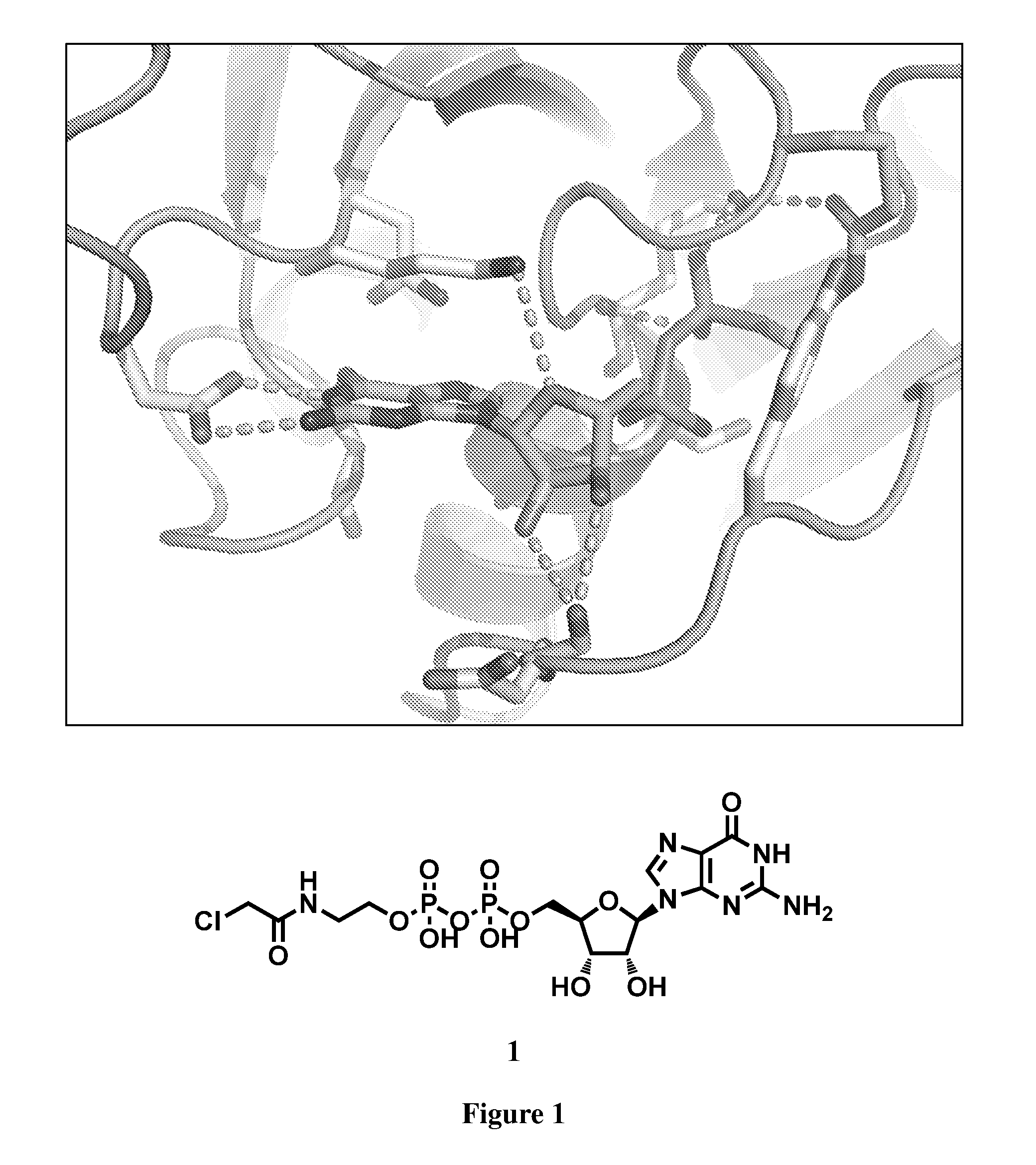Ras inhibitors and uses thereof
a technology of ras and inhibitors, applied in the field of ras inhibitors, can solve the problem of high difficulty in targeting ras
- Summary
- Abstract
- Description
- Claims
- Application Information
AI Technical Summary
Benefits of technology
Problems solved by technology
Method used
Image
Examples
example 1
2-acrylamidoethyl(((2R,3S,4R,5R)-5-(2-amino-6-oxo-1H-purin-9(6H)-yl)-3,4-dihydroxytetrahydrofuran-2-yl)methyl) hydrogen phosphate
[0316]
Step 1. tert-butyl(2-(((((3aR,4R,6R,6aR)-6-(2-amino-6-oxo-1H-purin-9(6H)-yl)-2,2-dimethyltetrahydrofuro[3,4-d][1,3]dioxol-4-yl)methoxy)(2-cyanoethoxy)phosphoryl)oxy)ethyl)carbamate
[0317]
[0318]To a solution of tert-butyl(2-hydroxyethyl)carbamate (45.0 μL, 0.29 mmol) in DMF (2 mL) were added DIPEA (152.0 μL, 0.87 mmol) and 3-((chloro(diisopropylamino)phosphino)oxy)propanenitrile (97.3 μL, 0.44 mmol) at 0° C. The reaction mixture was warmed up to ambient temperature and stirred for 1 h. 2′,3′-O-Isopropylideneguanosine (70.5 mg, 0.22 mmol) and 5-(ethylthio)-tetrazole (113.2 mg, 0.87 mmol) were added to the mixture that was stirred for another 1 h. Subsequently, m-CPBA (70%, 53.7 mg, 0.22 mmol) was added, and the mixture was stirred for 1 h. The mixture was diluted with DMSO (1 mL), and directly purified by preparative reverse-phase HPLC (methanol / water g...
example 2
(2-chloroacetamido)-(((((((2R,3S,4R,5R)-5-(2-amino-6-oxo-1H-purin-9(6H)-yl)-3,4-dihydroxytetrahydrofuran-2-yl)methoxy)(hydroxy)phosphoryl)oxy)(hydroxy)phosphoryl)oxy)ethane
[0323]
Step 1. tert-butyl(2-((bis(benzyloxy)phosphoryl)oxy)ethyl)carbamate
[0324]
[0325]To a mixture of tert-butyl(2-hydroxyethyl)carbamate (1.0 g, 6.2 mmol) and dibenzyl diisopropylphosphoramidite (4.2 mL, 12.4 mmol) was added a 0.45 M acetonitrile solution of tetrazole (42 mL, 18.6 mmol) at ambient temperature. The resulting solution was stirred at ambient temperature for 4 h. Then, at ambient temperature, m-CPBA (70%, 4.59 g, 18.6 mmol) was added to the reaction mixture that was stirred for further 1 h. The precipitate in the mixture was filtered through a pad of celite®, and the filter cake was further washed with dichloromethane (100 mL). The combined filtrate was diluted with dichloromethane (50 mL) and washed with a saturated aqueous solution of sodium bicarbonate (100 mL, five times) and brine (100 mL). The o...
example 3
(2S)-2-propylpentyl 2-(((((((2R,3S,4R,5R)-5-(2-amino-6-oxo-1H-purin-9(6H)-yl)-3,4-dihydroxytetrahydrofuran-2-yl)methoxy)(hydroxy)phosphorypoxy)(2-(2-chloroacetamido)ethoxy)phosphoryl)amino)propanoate
[0336]
Step 1. (2S)-2-propylpentyl 2-(((((((2R,3S,4R,5R)-5-(2-amino-6-oxo-1H-purin-9(6H)-yl)-3,4-dihydroxytetrahydrofuran-2-yl)methoxy)(hydroxy)phosphoryl)oxy)(2-aminoethoxy)phosphoryl)amino)propanoate
[0337]
[0338]To a solution of (S)-2-((tert-butoxycarbonyl)amino)propanoic acid (1.14 g, 6.0 mmol) in dichloromethane (14.2 mL) were added 2-propylpentan-1-ol (941.4 μL, 6.0 mmol), DMAP (73.3 mg, 0.6 mmol), and EDCI (1.27 g, 6.6 mmol) at ambient temperature. The resulting dark yellow solution was stirred at ambient temperature for 14 h. It was diluted with ethyl acetate (100 mL), and washed with a saturated aqueous solution of sodium bicarbonate (100 mL, three times) and brine (100 mL, twice). The organic layer was dried with sodium sulfate, filtered, and concentrated in vacuo. The residue con...
PUM
| Property | Measurement | Unit |
|---|---|---|
| Pharmaceutically acceptable | aaaaa | aaaaa |
| Cell growth | aaaaa | aaaaa |
Abstract
Description
Claims
Application Information
 Login to View More
Login to View More - R&D
- Intellectual Property
- Life Sciences
- Materials
- Tech Scout
- Unparalleled Data Quality
- Higher Quality Content
- 60% Fewer Hallucinations
Browse by: Latest US Patents, China's latest patents, Technical Efficacy Thesaurus, Application Domain, Technology Topic, Popular Technical Reports.
© 2025 PatSnap. All rights reserved.Legal|Privacy policy|Modern Slavery Act Transparency Statement|Sitemap|About US| Contact US: help@patsnap.com



